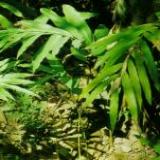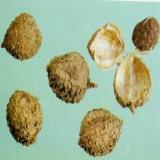Amomum Fruit
http://www.100md.com
《e Natural Health Center》
 |
 |
 |
Aromatic Herbs for Resolving Dampness
Amomum Fruit
Latin:
Fructus Amomi
Origin:
The dried ripe fruit of Amomum villosum Lour. (villous amomum) or Amomum longili gulare T. L. Wu (Hainan amomum) or Amomum villosum var. xanthiodes (Wall. ex Bak.), T. L. Wu et Senjen (cocklebur-like Amomum), a perennial herb, of the Zingiberaceae, or ginger family.
, 百拇医药
The majority species of the Zingiberaceae family are shade plants of the rain forest of evergreen tropical regions, although some grow mainly on forest margins, in clearings, or on riverbanks. Within a single genus (e.g., Musa, Costus) some species may grow only in shade while others grow in more open places.
All members of the family Zingiberaceae have brightly coloured flowers and slender flower tubes full of nectar. They are probably mostly pollinated by butterflies. Flowers are, in all cases, short-lived, often lasting only a few hours.
, 百拇医药
In almost all members of the order, the long leaf sheaths overlap, so that the true stem bearing them is not exposed. The stem is slender and lacks firm tissues, the leaf sheaths (the inner ones of which are very long) providing the necessary rigidity. As a consequence, the only fully exposed stems occur where the flowering stalk projects above the false stem of leaf sheaths.
In some species of Amomum, moisture may be provided by the rotting of main bracts so that fruits develop in a mass of black putrescence maintained in a wet state by frequent rains.
, http://www.100md.com
In China, villous amomum is mainly produced in the provinces Guangdong, Guangxi and other parts of China; Hainan amomum is mainly produced in Guangdong, Hainan Island and Zhanjiang Prefecture; cocklebur-like amomum is produced in Vietnam, Thailand, Indonesia, etc. Of these, villous amomum is of the best quality.
The herb is harvested in summer and autumn when the fruit ripens. It is dried in the sun or in low heat and pounded for use when raw.
, 百拇医药
Properties:
Pungent in flavor, warm in nature, it is related to the spleen and stomach channels.
Functions:
Removes dampness, promotes the flow of qi, warms the spleen and stomach, arrests vomiting and diarrhea and prevents miscarriage.
Applications:
1. To treat syndromes of disturbance of the spleen due to dampness and stagnation of qi in the spleen and stomach:
, 百拇医药
This herb is often used together with official magnolia bark, dried tangerine peel, immature citron or trifoliate orange (Fructus Aurantii Immaturus), etc.
2. To treat vomiting and diarrhea due to insufficiency of spleen-yang:
This herb can be ground alone into powder for swallowing or used together with such herbs as dried ginger, monkshood root (Radix Aconiti praeparata), etc.
3. To treat pernicious vomiting during pregnancy and threatened abortion due to stagnation of qi:
, http://www.100md.com
a) Failure to eat due to vomiting and regurgitation during pregnancy:
This herb is parched alone until cooked and ground into powder for oral administration, e.g., Suosha San in the book 'Standards of Diagnosis and Treatment'.
b) Threatened abortion:
It can be used in combination with ginseng, milk vetch root (Radix Astragali seu Hedysari), largehead atractylodes rhizome (Rhizoma Atractylodis Macrocephalae), etc., e.g., Taishan Panshi San.
, 百拇医药
Dosage and Administration:
3-6 g.
Decoct this herb for oral administration.
Cautions on Use:
Reference Materials:
'On Properties of Herbs' :
"Treating abdominal pain due to cold-qi, recurrent dysentery due to stagnation of qi and internal injuries caused by overstrain by eliminating undigested food and warming the spleen and stomach."
, 百拇医药
'Kai Bao Materia Medica' :
"Cold dysentery due to consumption, indigestion, dysentery with blood and mucus, lumps in the abdomen and flatulence."
Toxic or Side Effects:
Modern Researches:
Villous amomum contains a volatile oil with gum camphor, borneol, limonene, nerolidol and saponins as its main ingredients. Cocklebur-like amomum contains a volatile oil with camphor, a terpene, etc., as its main ingredients.
Amomum volatile oil can strengthen the stomach with its aromatic property, promote the secretion of gastric juice and remove accumulated qi from the digestive tract, so it can promote the flow of qi and relieve flatulence., http://www.100md.com